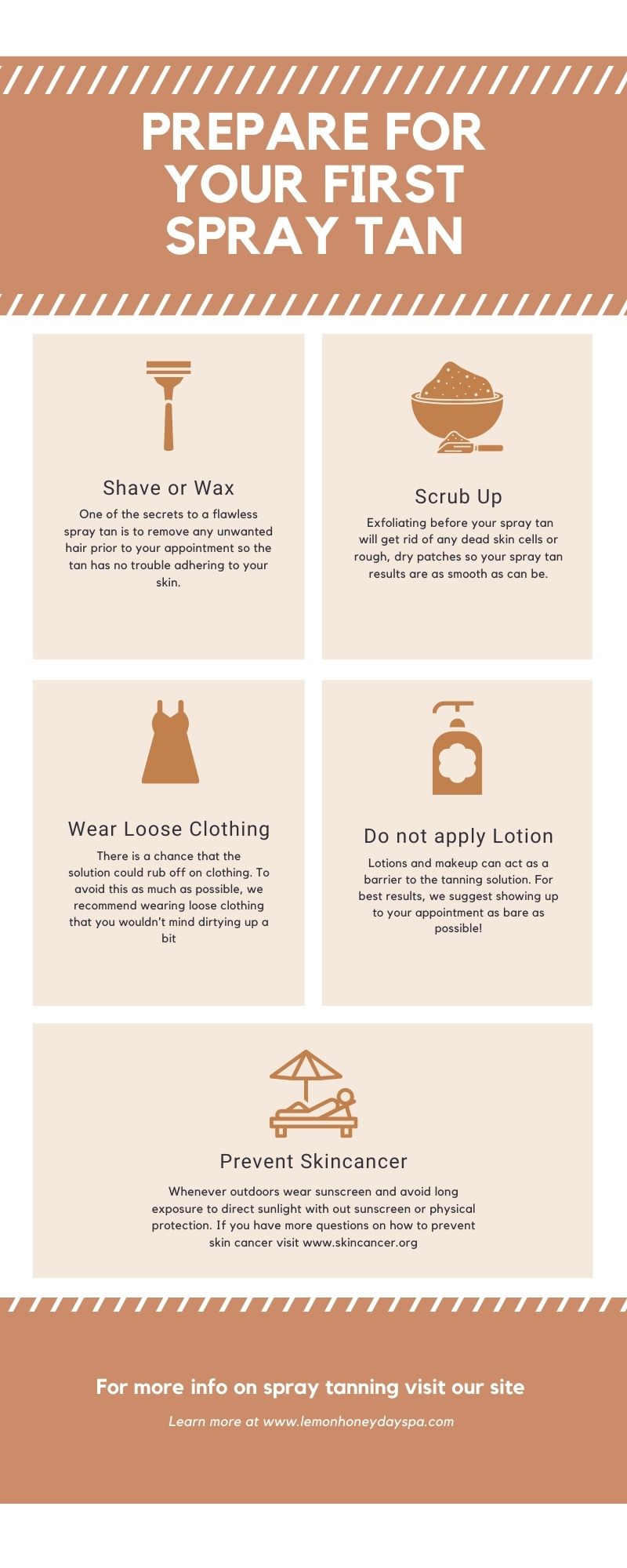
Spray tanning is a method of applying a temporary, cosmetic tan to the skin. This is done by spraying a fine mist of tanning solution onto the skin, which contains a chemical called dihydroxyacetone (DHA). DHA reacts with the amino acids in the skin’s top layer (the epidermis) to produce a brown pigment called melanin, which is the same pigment that gives skin its natural color.
Spray tans have become increasingly popular in recent years as a safer alternative to sunbathing. Unlike sunbathing, which can damage the skin and increase the risk of skin cancer, spray tans do not involve exposure to ultraviolet (UV) radiation. Spray tans are also more consistent than sunbathing, resulting in an even, natural-looking tan.
The process of getting a spray tan typically takes about 15-20 minutes. Before the spray tan, the skin should be clean and free of any lotions or oils. The person getting the spray tan will stand in a spray booth, and the technician will use a spray gun to apply the tanning solution to the skin. The solution is applied in a thin, even layer, and it will take about 8-12 hours for the full color to develop.
Spray tans can last for about 5-7 days, depending on how well the skin is cared for. To extend the life of a spray tan, it is important to keep the skin hydrated and avoid exfoliating.
1. Chemical Reaction
This chemical reaction is the basis of how spray tans work. Dihydroxyacetone (DHA) is a colorless sugar molecule that reacts with the amino acids in the skin’s top layer to produce melanin, the same pigment that gives skin its natural color. When DHA is applied to the skin, it penetrates the epidermis and reacts with the amino acids in the keratin, a protein that makes up the skin’s cells.
The reaction between DHA and amino acids produces a brown pigment called melanoidin. Melanoidin is similar to the melanin that is produced by the skin in response to UV radiation, but it is not as long-lasting. Spray tans typically last for about 5-7 days, depending on how well the skin is cared for.
The chemical reaction between DHA and amino acids is a safe and effective way to achieve a temporary tan. Spray tans do not involve exposure to UV radiation, which can damage the skin and increase the risk of skin cancer. Spray tans are also more consistent than sunbathing, resulting in an even, natural-looking tan.
2. Temporary Tan
Spray tans are temporary because the chemical reaction between DHA and amino acids produces a temporary pigment called melanoidin. Melanoidin is not as long-lasting as the melanin that is produced by the skin in response to UV radiation, so spray tans typically fade within 5-7 days.
The temporary nature of spray tans is both an advantage and a disadvantage. On the one hand, it means that spray tans are a safe and effective way to achieve a temporary tan without exposing the skin to harmful UV radiation. On the other hand, it means that spray tans require regular reapplication to maintain the desired color.
The duration of a spray tan can be affected by several factors, including the type of DHA solution used, the application technique, and the individual’s skin type. Darker DHA solutions and multiple applications will produce a darker, longer-lasting tan. Oily or dry skin types may also affect the longevity of a spray tan.
Understanding the temporary nature of spray tans is important for managing expectations and achieving the desired results. By following proper care instructions and reapplying the spray tan as needed, individuals can enjoy a safe and beautiful tan for up to a week.
Even Application
Spray tanning involves spraying a fine mist of tanning solution onto the skin, ensuring an even distribution of DHA, the active ingredient responsible for the tanning effect. Unlike traditional self-tanning lotions or creams that can often result in streaks or uneven patches, spray tans deliver a consistent and natural-looking color.
The even application of spray tans is particularly important for achieving a seamless, believable tan. Streaks or blotches can ruin the overall aesthetic, making the tan look artificial or unnatural. By using a spray tan machine, the tanning solution is evenly distributed across the entire surface of the skin, avoiding the common pitfalls associated with manual application methods.
Furthermore, spray tans can be customized to match the individual’s desired shade of tan. By adjusting the concentration of DHA in the solution and the number of coats applied, technicians can create a tan that ranges from subtle and natural to deep and bronzed. The even application of the spray tan ensures that the resulting color is uniform and aesthetically pleasing.
The even and natural-looking tan achieved through spray tanning has significant practical and social implications. It allows individuals to enhance their appearance and boost their confidence without the harmful effects of UV radiation or the streaky, unnatural results of some self-tanning products. Additionally, spray tans can be particularly beneficial for special occasions or events where a flawless, even tan is desired.
3. UV-Free
Spray tans work by utilizing a chemical called dihydroxyacetone (DHA) to react with the skin’s amino acids, producing a brown pigment called melanin. This process, known as the Maillard reaction, mimics the natural tanning process triggered by UV radiation but without the harmful effects associated with sun exposure.
Unlike traditional tanning methods that rely on UV radiation, spray tans offer a safer alternative by eliminating the risk of sunburn, premature aging, and skin cancer. UV radiation damages the skin’s DNA, leading to wrinkles, age spots, and an increased risk of skin cancer. By avoiding UV exposure, spray tans provide a safer way to achieve a tanned appearance without compromising skin health.
The absence of UV radiation in spray tanning makes it particularly beneficial for individuals with sensitive skin, allergies, or a history of skin cancer. It allows them to enjoy a tanned look without experiencing adverse reactions or exacerbating existing skin conditions.
Furthermore, spray tans offer a more controlled and customizable tanning experience compared to sunbathing. The concentration of DHA in the tanning solution and the number of applications can be adjusted to achieve the desired shade of tan, ensuring a natural-looking result tailored to individual preferences.
4. Customization
Spray tans offer a high level of customization, allowing individuals to achieve a wide range of tan shades tailored to their preferences and skin tone. This customization is possible due to the controlled application of dihydroxyacetone (DHA), the active ingredient in spray tans.
- Concentration of DHA: The concentration of DHA in the tanning solution directly affects the depth of the tan. Higher concentrations of DHA result in darker tans, while lower concentrations produce lighter shades.
- Number of Applications: The number of applications of the spray tan solution also influences the shade of the tan. Multiple applications allow for a gradual build-up of color, enabling individuals to achieve their desired darkness gradually.
- Skin Type: Different skin types react differently to spray tans. Fairer skin tones tend to tan more quickly and may require fewer applications to achieve the desired shade, while darker skin tones may require more applications or a higher concentration of DHA.
- Personal Preferences: Ultimately, the shade of the spray tan is a matter of personal preference. Some individuals may prefer a subtle, natural-looking tan, while others may opt for a darker, more dramatic look.
The ability to customize spray tans empowers individuals to achieve a tan that complements their skin tone and personal style. By understanding how DHA concentration, number of applications, skin type, and personal preferences influence the shade of the tan, individuals can make informed decisions to achieve their desired results.
5. Professional Application
Professional application plays a crucial role in the effectiveness and safety of spray tans. Trained professionals possess the knowledge, skills, and equipment necessary to ensure an even, natural-looking tan while minimizing the risk of adverse reactions or uneven application.
- Expertise and Training: Trained professionals undergo specialized training to understand the chemistry behind spray tanning solutions, different skin types, and application techniques. This expertise enables them to customize the spray tan to each individual’s skin tone and preferences, achieving optimal results.
- Specialized Equipment: Professional spray tan booths are designed to provide a controlled environment with proper ventilation and lighting. The equipment used, such as spray guns and air compressors, is calibrated to deliver a fine, even mist of tanning solution, ensuring a smooth, streak-free finish.
- Safety and Hygiene: Trained professionals adhere to strict hygiene protocols to prevent the transmission of infections or skin irritations. They use disposable gloves, clean equipment, and follow proper sanitization procedures to maintain a safe and hygienic environment.
- Consultation and Aftercare: Before applying the spray tan, professionals typically conduct a consultation to assess the client’s skin type, desired shade, and any potential allergies. They also provide aftercare instructions to help clients maintain their tan and avoid common pitfalls, such as premature fading or uneven wear-off.
Overall, the professional application of spray tans ensures a safe, effective, and aesthetically pleasing tanning experience. Trained professionals leverage their expertise, specialized equipment, and adherence to safety protocols to deliver high-quality spray tans that meet the individual needs and preferences of their clients.
FAQs on Spray Tanning
This section addresses frequently asked questions about spray tanning to provide comprehensive information and address common concerns or misconceptions.
Question 1: How do spray tans work?
Answer: Spray tans work by utilizing a chemical called dihydroxyacetone (DHA), which reacts with the amino acids in the skin’s top layer to produce melanin, the same pigment that gives skin its natural color. This process, known as the Maillard reaction, mimics the natural tanning process triggered by UV radiation but without the harmful effects associated with sun exposure.
Question 2: Are spray tans safe?
Answer: Spray tans are generally considered safe when performed by trained professionals using reputable products. However, it is important to note that some individuals may experience mild skin irritation or allergic reactions. It is always advisable to conduct a patch test before a full-body spray tan and to follow the aftercare instructions provided by the technician.
Question 3: How long do spray tans last?
Answer: The longevity of a spray tan typically ranges from 5 to 7 days, depending on factors such as skin type, preparation, aftercare, and environmental exposure. Proper skin preparation, including exfoliation and moisturizing, can help extend the life of the tan.
Question 4: Can spray tans provide protection from the sun?
Answer: No, spray tans do not offer any protection from the sun’s harmful UV rays. It is essential to use sunscreen when exposed to sunlight, regardless of whether or not you have a spray tan.
Question 5: Are spray tans suitable for all skin types?
Answer: Spray tans can be customized to suit most skin types. However, individuals with sensitive skin or certain skin conditions may want to consult with a dermatologist before getting a spray tan.
Question 6: How can I maintain my spray tan?
Answer: To maintain your spray tan, it is important to avoid excessive sweating, exfoliating, or using harsh soaps. Moisturizing regularly and using products specifically designed for spray tan maintenance can help prolong the tan’s appearance.
By understanding these key points, individuals can make informed decisions about spray tanning and achieve a safe, natural-looking tan that complements their skin tone and lifestyle.
Transition to the Next Section: For more detailed information on spray tan maintenance and troubleshooting common issues, please refer to the “Spray Tan Care and Maintenance” section.
Spray Tanning Tips
To achieve a flawless, long-lasting spray tan, follow these professional tips:
Tip 1: Exfoliate Beforehand
Exfoliating the skin prior to a spray tan helps remove dead skin cells, resulting in a smoother, more even tan application. Use a gentle exfoliating scrub and avoid harsh products that may irritate the skin.
Tip 2: Moisturize Regularly
Moisturizing the skin before and after a spray tan helps to hydrate the skin and prevent the tan from fading prematurely. Use a fragrance-free, oil-free moisturizer to avoid interfering with the tanning solution.
Tip 3: Avoid Sun Exposure
Exposure to UV rays can damage the skin and cause the spray tan to fade more quickly. Limit sun exposure and use sunscreen to protect the skin when outdoors.
Tip 4: Wear Loose Clothing
Tight clothing can rub against the skin and cause the spray tan to wear off unevenly. Wear loose, comfortable clothing after a spray tan to prevent friction and maintain an even tan.
Tip 5: Avoid Swimming and Hot Showers
Swimming in chlorinated water and taking hot showers can strip the skin of its natural oils and cause the spray tan to fade more quickly. Limit these activities or use lukewarm water and avoid harsh soaps.
Summary: By following these tips, you can enhance the longevity and appearance of your spray tan, ensuring a radiant, sun-kissed glow.
Transition to Conclusion: To extend the life of your spray tan even further, consider investing in spray tan maintenance products and following a consistent skincare routine.
How Do Spray Tans Work
Spray tanning has revolutionized the way individuals achieve a sun-kissed glow without the harmful effects of UV radiation. By utilizing the Maillard reaction to produce melanin in the skin, spray tans offer a safe and effective alternative to traditional tanning methods. Customizable to suit various skin tones and preferences, spray tans provide an even, natural-looking tan that can be tailored to personal desires.
Understanding the science behind spray tanning empowers individuals to make informed decisions about their tanning choices. By following recommended practices for preparation, maintenance, and aftercare, individuals can maximize the longevity and appearance of their spray tans. Whether seeking a subtle enhancement or a more dramatic transformation, spray tanning offers a versatile and convenient solution for achieving a radiant, healthy-looking tan.



